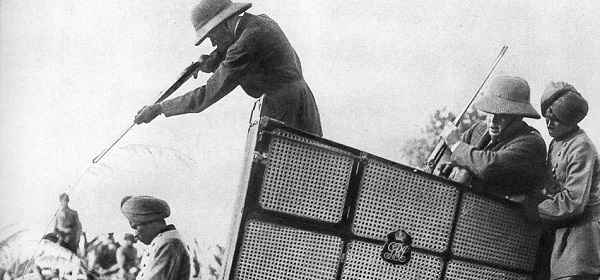George V's 1911 hunting trip in Nepal
Over 18–28 December 1911, King George V of the United Kingdom took part in a hunt in the Kingdom of Nepal as part of an expedition organised by the Prime Minister of Nepal, Chandra Shumsher Jang Bahadur Rana. The king had wanted to visit Nepal in 1905 but due to the ongoing 1899–1923 cholera pandemic, he could not enter the region. The crew killed 39 tigers, 18 rhinoceros, 4 bears, and several porcupines and leopards over the course of the 10-day expedition. During the hunt, the king knighted Chandra Shumsher with the Royal Victorian Order.
The British royals started to hunt in Nepal in 1876 after Nepali Prime Minister Jung Bahadur Rana invited Albert Edward (later King Edward VII) to an expedition which killed about 23 tigers in two weeks. Later many foreign dignitaries were invited by the Rana dynasty, including Archduke Franz Ferdinand of Austria, George Curzon, 1st Marquess Curzon of Kedleston, and Prince Albert Victor, Duke of Clarence and Avondale.
In 1905, Prince George, the future George V, King of the United Kingdom, wanted to visit the Kingdom of Nepal for a hunt but due to the ongoing 1899–1923 cholera pandemic he could not. In 1911, Prime Minister of Nepal Chandra Shumsher Jang Bahadur Rana invited George V to participate in big game hunting in Terai. Preparing for the hunt, Chandra Shumsher spent months collecting 645 elephants and bullocks and tied them in jungles to lure the tigers. The King of Nepal Prithvi Bir Bikram Shah died on 11 December but the preparations did not stop.
Thousands of elephant beaters were employed "to drive the game toward his waiting guns". About this event, George V told Charles Hardinge, 1st Baron Hardinge of Penshurst: "As probably this will be the last and only time in my life when I shall get big game shooting of this kind, I naturally want to have as many days in Nepal as possible". The Terai region of Nepal was protected from hunting's by rulers of Nepal but since 1846 it was allowed if the person obtained a permit from Maharajah or the Prime Minister. A few specimens from Nepal were shown in international museums such as The Royal College of Surgeons of England, and Indian Museum, Kolkata.
